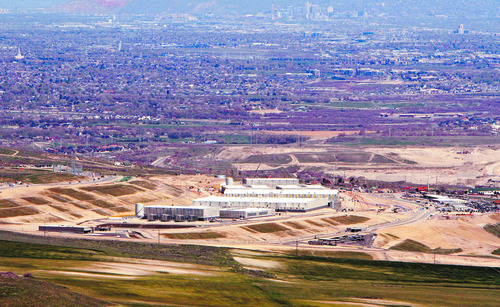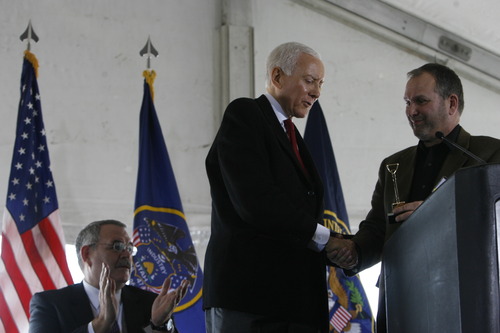This is an archived article that was published on sltrib.com in 2013, and information in the article may be outdated. It is provided only for personal research purposes and may not be reprinted.
With the opening of the National Security Agency's Utah Data Center, The Tribune's staff has compiled a list of common questions and their answers.
• Is someone at the Utah Data Center going to be reviewing my Internet and phone history?
All indications are no. First, we'll give you the obligatory NSA refrain that it does not spy on Americans. Regardless, the Utah Data Center is a storage facility. Your digital footprint, or part of it, may reside there, but any analysis of whether your search engine queries for rifles or the latest BYU football news represents a national security threat will be done at other federal facilities by personnel who can remotely access the information stored in Bluffdale. The Utah Data Center is expected to have only 200 employees; not enough to sort through the records of the average American.
—
• How is the NSA going to sort all those records?
That remains to be seen. If the NSA has the name of a potential terrorist, technology is sufficient to find that person's digital history. The trick is identifying terror suspects based on what they do online or on the phone before they commit a crime or associate with terror suspects and that is where the NSA is waiting for technology and mathematics to catch up. Private contractors have said the NSA has purchased Cray XC30 supercomputers. Industry officials say those machines can run up to 1 million Intel Xenon core processors simultaneously, enabling speeds of up to 100 petaflops. One petaflop is about one thousand trillion calculations per second. But it doesn't matter how fast you can calculate if you don't have the right algorithm. The NSA, other government agencies and private-sector scientists are racing to build new data-mining algorithms, drawing on a blend of mathematics, machine learning, artificial intelligence and database theory. In March, President Barack Obama announced a $200 million research initiative across seven federal agencies to advance techniques for data mining. This issue hits on one debate about the NSA and its intelligence-gathering. Critics have said the agency is collecting more data than it can manage and far, far more than can ever be useful.
—
• Is all of the NSA's intelligence going to be stored in Utah?
No. The NSA has other storage facilities, including at its headquarters at Fort Meade, Md., and in Georgia, Texas, Colorado and Hawaii. What's more, the data in Utah is not unique. With billions of dollars from Congress, the NSA during the Obama administration has created what is essentially a colossal network of backup hard drives. If the power grid in Utah or Texas goes down, for example, the NSA can still access stored information from another data center.
—
• Why did the NSA pick Utah?
John Inglis, the NSA's deputy director and the top civilian at the agency, told The Tribune a number of factors favored Bluffdale and Camp Williams. One of the biggest, as articulated by Inglis and other sources who have spoken to the newspaper, appears to be the same thing that has drawn private-sector data centers to the mountain states — cheap electricity. The NSA also wanted a secure location, and an Army post is pretty secure. Other factors included a skilled workforce and a site with little threat from natural disasters.
—
• And because Mormons are in Utah, right?
The Tribune staff has received a lot of questions about whether Mormons, and their reputation for conservatism, loyalty and secret-keeping, deserved or not, were why the NSA built a data center in Utah. But there's no evidence Mormons were a factor. The issue did not arise when two Tribune reporters interviewed NSA administrators in May at Fort Meade, Md. State and local officials in Utah who have been in contact with the NSA have said the issue has not been mentioned. If Mormons were that important, the NSA would have put a data center in Rexburg, Idaho. Ninety-five percent of Rexburg's 25,000 residents are LDS, according to a 2004 article in The Church News. —
• Is the Utah Data Center going to increase electric rates?
Rocky Mountain Power and the Utah Public Service Commission say no. This concern arises from the fact that the Utah Data Center will use 65 megawatts of electricity (a single megawatt is enough to run appliances in 500 to 750 homes) and industrial users in Utah pay a lower rate than residential users. But the Public Service Commission says industrial users compensate in the volume in which they buy electricity. Also, the NSA had to pay for construction of a substation to serve the data center. Rocky Mountain Power's largest Utah customer is Kennecott Utah Copper, which uses about 200 megawatts.
—
• Can I tour the Utah Data Center?
No. You're not even suppose to drive into the parking lot. A few Utah dignitaries have received tours. Most of them have been reticent to discuss what they saw there.
—
• Will the Utah Data Center provide jobs?
Some, but not many. The $1.2 billion construction project employed about 1,000 workers for two years, but those jobs are gone. As mentioned, the Utah Data Center will employ only about 200 people. Bluffdale is trying to lure some more private-sector data centers to town, hoping the NSA has raised Bluffdale's profile. But private-sector data centers don't employ many people either. The NSA installed new utility lines from Bluffdale through the currently-open desert to the Utah Data Center, and city planners have discussed using those lines to facilitate new home and business construction. Such development remains years away and it's unclear how much economic benefit it will provide.
— Compiled by Nate Carlisle with reporting from Thomas Burr, Matt Canham, Steve Oberbeck and Tony Semerad.





